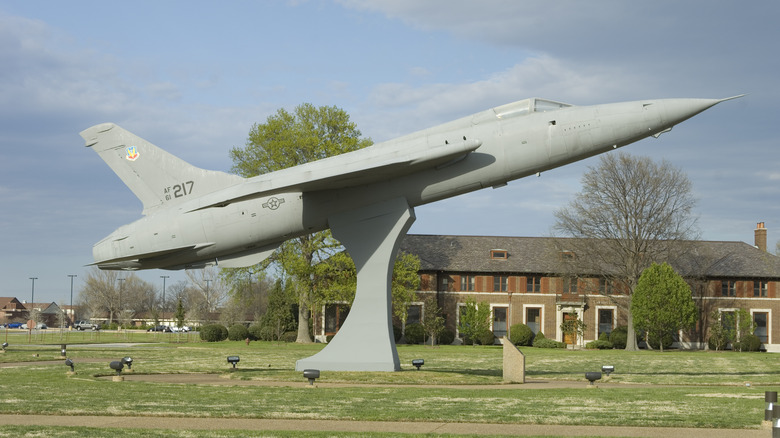How The F-105 Thunderchief Became An Icon Of The Skies
After WWII, people at the Pentagon thought seriously about fighting and winning a nuclear war. Neither nuclear submarines nor ICBMs had yet been invented, so the primary way of delivering the devastating weapons was dropping them from planes. In 1950, the U.S. Air Force requested proposals for a supersonic fighter-bomber that could handle nuclear weapons. Republic Aviation submitted the winning proposal, the YF-105A. It was built to be fast and had an internal bomb bay where the nuclear bombs would be stowed, making it a likely design for its intended purpose. The YF-105A broke the sound barrier on its very first flight and was capable of just over Mach 2 at altitude.
The F-105's design phase took longer than expected, and the first production model was not delivered until 1958. By the time the F-105 was used in combat, it was on version D, and its mission had been changed from nuclear to conventional bombing. It did most of its fighting in Vietnam, where it distinguished itself by destroying North Vietnamese surface-to-air missile batteries and fighting MiGs, even as it garnered a reputation for producing too many casualties. If you have seen photos from the Vietnam War, you have probably seen the F-105 Thunderchief. It continues the trend of "Thunder" in the name of Republic Aviation warplanes (starting with their P-47 Thunderbolt).
Design and development
The new plane commissioned by the Air Force was intended as a replacement for the F-84F Thunderstreak. The prototype was delivered in 1952. The development phase of the YF-105A (as it was known at first) was pretty rocky. Its difficulties came about through changing military needs (the Korean War was coming to a close, threatening the procurement contract) and a design so large it required a more powerful engine halfway through its development.
The first production model, the YF-105B, was delivered in 1958, and by 1959, more shifting priorities led to the further development of the most common type of F-105, the F-105D, which had its internal bomb bay sealed and filled with an extra fuel tank. The Thunderchief was built for speed and payload size, not to be agile and maneuverable like typical fighters. Its massive 12,000-pound payload capacity, Mach 2 speed, and extensive range — courtesy of the added fuel tanks and the Thunderchief's mid-air refueling capability — made it a good candidate for long-range bombing missions.
The F-105D was fitted with dual radar systems that converted it into an all-weather aircraft, requiring that the plane be lengthened by about a foot. It was also upgraded to the Thunderstick targeting and navigation system. Stronger landing gear and better brakes were needed. When all the modifications were made, the F-105D was much more battle-worthy, which was good because its main historical use would test its new capabilities to their limit.
Use in Vietnam
The modifications to upgrade the F-105B to the F-105D were completed just in time. It had a couple of years to shake out bugs (which included a brief stint as the Thunderbird's jet of choice), and then it was time for the F-105's main deployment. The Thunderchief was sent to Vietnam in large numbers in 1965 to participate in Operation Rolling Thunder, the bombing campaign against North Vietnam. By the war's end, it was calculated that the F-105D had flown roughly 75% of all the bombing runs the U.S. had conducted. By this time, the plane had already acquired its nickname, Thud.
The Thunderchief was assigned to bomb bridges, facilities, and surface-to-air missile sites. It achieved many objectives and even shot down a few MiGs that were sent against it. But its successes came at a high price. Throughout the war, 334 F-105Ds were shot down. That's out of a total production run of 610 of the F-105D variant — more than half.
Upgrading some of the jets to the F-105G "Wild Weasal" variant and the EF-105G version equipped with anti-radiation missiles as escorts for the F-105Ds helped, but not enough. Before the Vietnam War ended, the Thunderchief was largely replaced by the F-4 Phantom II. It was taken out of active service entirely after the war.
Retirement
Perhaps because it was designed to carry nuclear bombs and then diverted to a more traditional combat role, the F-105 lacked the maneuverability of a fighter. This is the most likely reason why older MiG 17s were able to shoot down so many F-150s. A pilot had only a 75% chance of surviving 100 combat missions in a Thunderchief. When the war in Vietnam ended, the F-105 was quickly removed from active service units and reassigned to reserve and Air National Guard units. It is regarded as having been retired due to its high casualty rate.
The last F-105 was retired in 1984. Its last use was by the Georgia Air National Guard. Since then, the Thunderchief has been memorialized with a statue at Seymour Johnson Air Force Base, and retired units are on display at various Air Force bases around the country. Though it suffered many losses over North Vietnam, many feel that this reflects the danger and difficulty of the missions the Thunderchief's pilots took on and is not a sign of a sub-standard design. This fighter-bomber is remembered fondly by the pilots and crews who worked with it.



